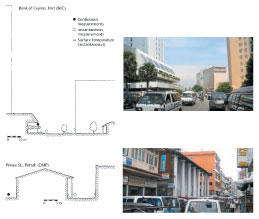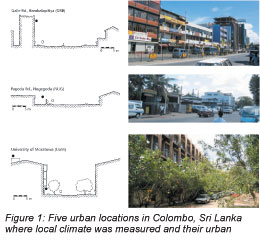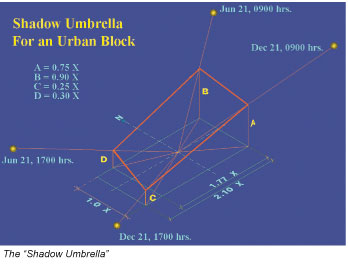|
by Rohinton EMMANUEL
 hat cities create their own microclimate, though intuitive, is a relatively new discovery. It was only in the mid nineteenth century that the scientific phenomenon now referred to as the "urban heat island" (UHI) came to be empirically established in London. The antecedent of our knowledge of tropical urban heat islands is even shorter. In fact, Singapore was associated with one of the first known studies in tropical urban heat islands in the late 1960's. hat cities create their own microclimate, though intuitive, is a relatively new discovery. It was only in the mid nineteenth century that the scientific phenomenon now referred to as the "urban heat island" (UHI) came to be empirically established in London. The antecedent of our knowledge of tropical urban heat islands is even shorter. In fact, Singapore was associated with one of the first known studies in tropical urban heat islands in the late 1960's.
 The urban heat island can be visualized as a "hot patch in cool surroundings." In the tropical case, excessive amount of solar radiation and its near-zenith solar orientation, availability of abundant water from year-round rainfall and the proliferation of urban vegetation usually lead to much smaller temperature difference between city centre and rural surroundings. However, the intra-urban (i.e. between urban locations) variations are quite high in tropical cities. Our work in tropical Colombo (Sri Lanka) is typical of many studies where up to 8 degree Celsius temperature differences between urban locations have been recorded. In the context of annual temperature swings of 5-6 degrees, such urban variations are remarkable and many urban dwellers are intuitively aware of the juxtaposition of cool and hot spots within their cities. The urban heat island can be visualized as a "hot patch in cool surroundings." In the tropical case, excessive amount of solar radiation and its near-zenith solar orientation, availability of abundant water from year-round rainfall and the proliferation of urban vegetation usually lead to much smaller temperature difference between city centre and rural surroundings. However, the intra-urban (i.e. between urban locations) variations are quite high in tropical cities. Our work in tropical Colombo (Sri Lanka) is typical of many studies where up to 8 degree Celsius temperature differences between urban locations have been recorded. In the context of annual temperature swings of 5-6 degrees, such urban variations are remarkable and many urban dwellers are intuitively aware of the juxtaposition of cool and hot spots within their cities.
 Figure 1 shows five urban locations in Colombo, Sri Lanka, where we measured urban microclimate and their urban character. Figure 2 presents the results of our efforts. One interesting finding is that during the day, several urban locations were cooler than a rural reference station (marked "RUR" in Figure 2). Herein lies the basis for a possible mitigatory approach in tropical cities. With care and attention to detail, built-up areas can indeed utilize the shade they generate - together with urban vegetation - to cool neighborhoods even below rural areas. This is good news indeed, in the context of the population densities needed in the tropics to accommodate the ever-increasing urban population. Figure 1 shows five urban locations in Colombo, Sri Lanka, where we measured urban microclimate and their urban character. Figure 2 presents the results of our efforts. One interesting finding is that during the day, several urban locations were cooler than a rural reference station (marked "RUR" in Figure 2). Herein lies the basis for a possible mitigatory approach in tropical cities. With care and attention to detail, built-up areas can indeed utilize the shade they generate - together with urban vegetation - to cool neighborhoods even below rural areas. This is good news indeed, in the context of the population densities needed in the tropics to accommodate the ever-increasing urban population.
 UHIs in the tropics increasingly point to the need for shade. For too long the emphasis has been on ventilation, to the detriment of all other climate-sensitive design options. While there is no denying of the cooling effect of urban breeze, wind's cooling potential is greatly enhanced if accompanied by shade. A happy by-product of such shade is the possibility of accommodating very high density urban living, provided the densities are achieved without compromising the climatic quality of public places. UHIs in the tropics increasingly point to the need for shade. For too long the emphasis has been on ventilation, to the detriment of all other climate-sensitive design options. While there is no denying of the cooling effect of urban breeze, wind's cooling potential is greatly enhanced if accompanied by shade. A happy by-product of such shade is the possibility of accommodating very high density urban living, provided the densities are achieved without compromising the climatic quality of public places.
Our efforts towards such a realization have been underpinned by a concept introduced in the 1990s as "shadow umbrella". The approach is the reverse of the "solar right" movement in the West which seeks to ensure adequate sunlight to all buildings. What we advocate is an urban design ethos of shading of public places (i.e. a subversion of the solar right principle of "thou shall not cast shadow on thy neighbor's property" to a tropical axiom of "thou SHALL cast shadow on public spaces!")
The aim of Shadow Umbrella is not to shade buildings per se (nor is it desirable!) but to encourage an urban geometry that is self-shading of its interstitial spaces without compromising buildings' ability to draw in the sunlight as and when needed. The fact that tropical sun is so high in the sky (i.e. high zenith angles) mandates that we use an intelligent combination of building heights and geometry together with elements such as canopies, awnings and urban vegetation. Once the shading is thoughtfully arranged, the cooling potential of wind could be enhanced and this brings in the double benefit of high density living with enhanced cooling from urban winds.
The challenges facing tropical cities are two-fold - unique urban growth and unprecedented rate of growth. Tropical urbanization is unique in that it is not happening on the back of industrial growth but is driven by large migration of humanity in search of opportunities. It is unprecedented in the sense that such a growth is occurring within the space of a single generation. Tropical cities, especially the mega-cities, need unique and rapid solutions. The population densities which need to be accommodated at such rapid speed are truly mind-boggling. The challenge is further complicated by global warming which is making an already "problematic climate," as Trewartha put it in the 1950s, nearly intolerable. While this is the bad news, our understanding of the urban heat island effect in the tropics, its causes and especially its mitigation, offers hope that the same human-induced urban changes can be harnessed to enhance the climatic quality of our cities. An enlightened approach to urban design is therefore needed in the tropics. Rather than merely replicating the failing models of urbanity from the West, tropical cities need to chart a shade-oriented design ethos for their public spaces.
 The well-known Indian Architect Charles Correa wrote in the 1980s that the problem of housing high numbers of humans in cities is not solved by excessive densities but by sympathetic designing of high-quality public places. While high quality public spaces require many elements in the right combination to be successful, our studies of the UHI problem in the tropics is pointing to the need for shading as a key contributor to successful public spaces in urban tropics. The well-known Indian Architect Charles Correa wrote in the 1980s that the problem of housing high numbers of humans in cities is not solved by excessive densities but by sympathetic designing of high-quality public places. While high quality public spaces require many elements in the right combination to be successful, our studies of the UHI problem in the tropics is pointing to the need for shading as a key contributor to successful public spaces in urban tropics.
The unprecedented movement of people towards tropical cities might appear a problem at first, but our knowledge of the inner workings of tropical urban heat island does provide a means to enhance the quality-of-life of ever-increasing numbers of urban dwellers in the form of urban shading in public places. The fact that a majority of tropical dwellers are already living in cities (or on the cusp of doing so, especially in Asia) means we now have an opportunity to enhance the quality-of-life for a large segment of our citizenry. This is a good in itself, but to be able to do so in a warming world, gives hope that climate-sensitive tropical urban design has within its reach the tools for a better urban environment.
 Click here to download the full issue for USD 6.50 Click here to download the full issue for USD 6.50
|


 hat cities create their own microclimate, though intuitive, is a relatively new discovery. It was only in the mid nineteenth century that the scientific phenomenon now referred to as the "urban heat island" (UHI) came to be empirically established in London. The antecedent of our knowledge of tropical urban heat islands is even shorter. In fact, Singapore was associated with one of the first known studies in tropical urban heat islands in the late 1960's.
hat cities create their own microclimate, though intuitive, is a relatively new discovery. It was only in the mid nineteenth century that the scientific phenomenon now referred to as the "urban heat island" (UHI) came to be empirically established in London. The antecedent of our knowledge of tropical urban heat islands is even shorter. In fact, Singapore was associated with one of the first known studies in tropical urban heat islands in the late 1960's.
 The urban heat island can be visualized as a "hot patch in cool surroundings." In the tropical case, excessive amount of solar radiation and its near-zenith solar orientation, availability of abundant water from year-round rainfall and the proliferation of urban vegetation usually lead to much smaller temperature difference between city centre and rural surroundings. However, the intra-urban (i.e. between urban locations) variations are quite high in tropical cities. Our work in tropical Colombo (Sri Lanka) is typical of many studies where up to 8 degree Celsius temperature differences between urban locations have been recorded. In the context of annual temperature swings of 5-6 degrees, such urban variations are remarkable and many urban dwellers are intuitively aware of the juxtaposition of cool and hot spots within their cities.
The urban heat island can be visualized as a "hot patch in cool surroundings." In the tropical case, excessive amount of solar radiation and its near-zenith solar orientation, availability of abundant water from year-round rainfall and the proliferation of urban vegetation usually lead to much smaller temperature difference between city centre and rural surroundings. However, the intra-urban (i.e. between urban locations) variations are quite high in tropical cities. Our work in tropical Colombo (Sri Lanka) is typical of many studies where up to 8 degree Celsius temperature differences between urban locations have been recorded. In the context of annual temperature swings of 5-6 degrees, such urban variations are remarkable and many urban dwellers are intuitively aware of the juxtaposition of cool and hot spots within their cities.
 Figure 1 shows five urban locations in Colombo, Sri Lanka, where we measured urban microclimate and their urban character. Figure 2 presents the results of our efforts. One interesting finding is that during the day, several urban locations were cooler than a rural reference station (marked "RUR" in Figure 2). Herein lies the basis for a possible mitigatory approach in tropical cities. With care and attention to detail, built-up areas can indeed utilize the shade they generate - together with urban vegetation - to cool neighborhoods even below rural areas. This is good news indeed, in the context of the population densities needed in the tropics to accommodate the ever-increasing urban population.
Figure 1 shows five urban locations in Colombo, Sri Lanka, where we measured urban microclimate and their urban character. Figure 2 presents the results of our efforts. One interesting finding is that during the day, several urban locations were cooler than a rural reference station (marked "RUR" in Figure 2). Herein lies the basis for a possible mitigatory approach in tropical cities. With care and attention to detail, built-up areas can indeed utilize the shade they generate - together with urban vegetation - to cool neighborhoods even below rural areas. This is good news indeed, in the context of the population densities needed in the tropics to accommodate the ever-increasing urban population.
 The well-known Indian Architect Charles Correa wrote in the 1980s that the problem of housing high numbers of humans in cities is not solved by excessive densities but by sympathetic designing of high-quality public places. While high quality public spaces require many elements in the right combination to be successful, our studies of the UHI problem in the tropics is pointing to the need for shading as a key contributor to successful public spaces in urban tropics.
The well-known Indian Architect Charles Correa wrote in the 1980s that the problem of housing high numbers of humans in cities is not solved by excessive densities but by sympathetic designing of high-quality public places. While high quality public spaces require many elements in the right combination to be successful, our studies of the UHI problem in the tropics is pointing to the need for shading as a key contributor to successful public spaces in urban tropics.
 Click here to download the full issue for USD 6.50
Click here to download the full issue for USD 6.50